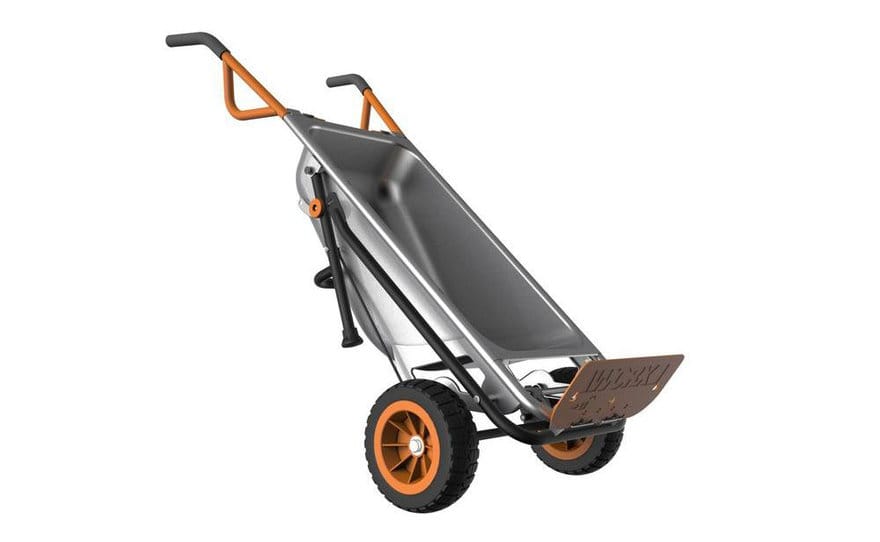Get ready to learn all the dirt—or soil, to be exact—about the wheelbarrow. This trusty tool has been around for ages, and it’s got a few surprises up its sleeves. We’ll dig into its history, see how it’s helped civilizations, and uncover some fun facts. From its ancient roots to its surprising uses today, the wheelbarrow is more than just a simple hauler. It’s a fascinating piece of human invention that’s made life just a little bit easier. So sit back, relax, and prepare to be amazed by the humble wheelbarrow.
Intriguing Facts About the Humble Wheelbarrow
You know the wheelbarrow, right? That one-wheeled wonder you see in gardens and on construction sites? Turns out, this seemingly simple tool has a rich history and a surprising impact on the world. Let’s dig a little deeper, shall we?
Origins Shrouded in Time
Believe it or not, evidence suggests the wheelbarrow has been around for ages, likely originating way back in ancient China during the Han Dynasty over 2,000 years ago! Back then, farmers and miners probably used it to haul heavy loads – a real game-changer for manual labor.
Imagine trying to build something as massive as the Great Wall of China without it! It’s mind-boggling to think about how this simple invention helped shape history.
More Than Just a Tool
But the wheelbarrow’s story goes beyond practicality. Over the centuries, it’s popped up in art and literature, often symbolizing hard work and the everyday struggles of ordinary people. This little workhorse even inspired some big inventions. Early prototypes for steam engines and even cars drew inspiration from its basic design! Who knew?
Evolving with the Times
Of course, the wheelbarrow hasn’t stayed frozen in time. These days, you can find high-tech versions powered by electricity, perfect for tackling tough jobs. And manufacturers are always coming up with clever features to make life easier for users – things like self-dumping mechanisms and adjustable handles.
The Future on One Wheel?
With growing concerns about the environment, some researchers are exploring eco-friendly wheelbarrow alternatives, trying to lessen their environmental impact. It’ll be interesting to see what innovations emerge in the years to come!
A World of Wheelbarrows
One fascinating aspect that often gets overlooked is how the design and use of wheelbarrows differ across the globe. Think about it – different cultures, terrains, and needs likely led to unique variations. Digging into these regional adaptations could offer a fresh perspective on this ubiquitous tool.
The humble wheelbarrow – a testament to human ingenuity, quietly impacting the world one load at a time. It makes you wonder what other simple tools around us hold hidden depths and fascinating stories, doesn’t it?
What are some interesting facts about wheelbarrows?
Alright, buckle up because we’re diving headfirst into the captivating history of the wheelbarrow – a tool that’s been quietly changing the game for centuries. You might think you know the humble wheelbarrow, but trust us, there’s more to it than meets the eye! Let’s take a look:
The Back-Saver That Changed the World
Imagine lugging around heavy stuff on your back all day. Ouch, right? That’s where the wheelbarrow struts in like a superhero! This clever invention shifted the weight from aching backs onto a simple wheel, making it way easier to transport hefty loads. It was a total game-changer for industries and everyday life. Think of it as the original moving dolly, but way more versatile!
From Ancient China to Your Backyard
The wheelbarrow isn’t just a one-hit-wonder; its influence has echoed through time and across continents. From its birthplace in ancient China to the fields of Europe, this handy tool has been a trusty sidekick for farmers, construction workers, gardeners, and pretty much anyone who needs to move stuff around. Talk about a global icon!
A Wheelbarrow for Every Occasion
Just like there’s no one-size-fits-all hat, wheelbarrows come in all shapes and sizes, each tailored for a specific job. Need to navigate a narrow passage? There’s a wheelbarrow for that. Tackling a heavy-duty construction project? We’ve got you covered. Just want to make your gardening chores a breeze? Yep, there’s a wheelbarrow for that too!
A Blast from the Past (Way, Way Back!)
Archaeologists have uncovered evidence suggesting that wheelbarrows have been around for a mind-bogglingly long time – we’re talking about ancient China, circa 2000 BCE! And get this, back then, they were crafted from wood and animal skins. Now that’s some serious old-school ingenuity!
From Humble Beginnings to High-Tech Helpers
Fast forward to today, and wheelbarrows have gone through some pretty impressive upgrades. We’re talking electric motors for effortless hauling, self-dumping mechanisms that make unloading a snap, and adjustable features for customized comfort. These modern marvels prove that even the simplest tools can benefit from a little technological boost!
Want to learn even more about the fascinating world of wheelbarrows? We’ve just scratched the surface! There’s a rich history of innovation and adaptation waiting to be explored.
How did the wheelbarrow get its name?
So, we’ve been talking about the history of the wheelbarrow, but have you ever stopped to think about where the name itself came from? It might seem pretty straightforward – it’s a barrow with a wheel, right? Well, you’re not wrong! But like most things from centuries past, there’s a bit more to the story.
The word “wheelbarrow,” as we know it, popped up in the English language sometime in the 14th century. Back then, folks were speaking Middle English, which slowly morphed from Old English – the language of the Anglo-Saxons. And it’s in those older tongues where we find the roots of “wheelbarrow.”
The “wheel” part is pretty self-explanatory – even back then, everyone knew what a wheel was! But the “barrow” part is a bit more interesting. It actually comes from the Old English word “barew.” Now, “barew” didn’t specifically mean wheelbarrow; it was a more general term for anything you could pile stuff onto and move around. Think of it like a catch-all term for things like handcarts, litters, or even just a big ol’ tray.
Put the two together – “wheel” and “barew,” and voila! You’ve got yourself a “wheelbarew,” which, over time, smoothed out its pronunciation to the “wheelbarrow” we use today.
It’s fascinating how language evolves, isn’t it? A simple word like “wheelbarrow” can give us a glimpse into how people lived and worked hundreds of years ago.
What are some facts about the wheelbarrow in ancient China?
We’ve been talking about the wheelbarrow, a tool you probably see every day on construction sites and gardens. It’s easy to take this simple machine for granted, but its story goes way back to ancient China, where it was anything but ordinary!
So, what’s so interesting about the wheelbarrow’s past? Well, imagine a time without cars, trucks, or even horses to pull heavy loads. During the Han Dynasty, around 2000 years ago, someone in China had a game-changing idea. They figured out that by putting a wheel in front of a platform, one person could easily move stuff that used to take several people. Talk about a back-saver!
At first, the Chinese government kept the wheelbarrow a secret. They knew a good thing when they saw it and realized this invention could give them an edge in battles. Can you imagine the surprise of enemy armies when the Chinese showed up with these wheeled wonders, easily transporting weapons and supplies? To keep their secret safe, official documents even used code words like “wooden goat” or “wooden ox” to describe the wheelbarrow.
But like most good ideas, the secret eventually got out. It wasn’t long before the wheelbarrow’s usefulness spread beyond the battlefield. Farmers used it to haul crops, builders used it to move materials, and everyday people found all sorts of ways to make their lives easier with this ingenious invention.
The history of the wheelbarrow reminds us that sometimes the simplest inventions can be the most impactful. What started as a clever military secret in ancient China changed the way we work and transport things forever. Pretty cool, huh?
What is the importance of the wheelbarrow?
We’ve talked about the history of the wheelbarrow, but let’s dive into why this simple tool is such a big deal even today. Think about it – the wheelbarrow completely changed how we move heavy stuff around. Before, you had to carry everything by hand or rely on animals, which wasn’t easy or fast.
One of the biggest things the wheelbarrow does is save your back (and your energy!). Imagine lugging around bags of concrete or piles of dirt all day. That’s where the wheelbarrow swoops in! Its design lets you move those hefty loads without feeling like you’ve run a marathon. This means fewer injuries and people being able to work longer without getting completely worn out.
Time is money, right? Well, the wheelbarrow gets that memo. It lets you move a whole lot more in one go compared to carrying things by hand. This bumps up efficiency, which is super important in jobs where every minute counts. Construction sites, gardens, farms – you name it, the wheelbarrow is probably there, quietly being a workhorse.
But the wheelbarrow isn’t a one-trick pony. It’s not just for flat, even ground. This little champion can handle bumpy fields, navigate around obstacles, and even deal with different kinds of materials, from rocks and sand to plants and tools. It’s like the multi-tool of the hauling world.
Now, even though the basic design of the wheelbarrow has been around forever, people are still finding ways to make it even better. We’re talking motorized versions, electric models, and who knows what else the future holds! These upgrades mean the wheelbarrow can tackle even tougher jobs and make things even easier for us.
While we might not always stop and think about it, the wheelbarrow is a silent hero in many ways. It’s a reminder that sometimes the simplest inventions have the biggest impact.
What are 3 uses of a wheelbarrow?
We’ve already talked about how awesome wheelbarrows are, but let’s dive into some specific ways people use these trusty tools! It’s likely you’ve encountered a wheelbarrow in several different settings – they’re surprisingly adaptable!
- Moving Stuff Around (and Making it Look Easy!): Imagine you’re tackling a big landscaping project. You’ve got piles of mulch, soil, and maybe even some decorative stones. Instead of breaking your back carrying everything by hand, a wheelbarrow lets you load it all up and move it with way less effort. This goes for construction sites, too – think bricks, bags of concrete, you name it. Wheelbarrows save time and energy, making them a go-to for hauling heavy stuff.
- Gardening’s Best Friend: Ask any gardener, and they’ll probably tell you a wheelbarrow is a must-have. It’s not just about moving heavy bags of soil, though that’s super helpful! Wheelbarrows help you transport plants, tools, and even garden waste. Their size means you can navigate narrow garden paths, and they’re tough enough to handle different types of terrain.
- Construction Can’t Live Without Them: Construction sites are like the ultimate proving ground for wheelbarrows. These workhorses are constantly on the move, transporting everything from concrete and bricks to tools and debris. Their ability to handle heavy loads over uneven ground makes them absolutely essential for keeping construction projects moving smoothly.
Thinking Beyond the Basics
While these are some core uses, keep in mind that people are always finding new and creative ways to put wheelbarrows to work. From DIY projects around the house to unique applications in different industries, the possibilities are pretty endless!
What are the features of a wheelbarrow?
We’ve been talking about wheelbarrows, those trusty tools that have been around for ages. But let’s dive a little deeper into what actually makes a wheelbarrow tick. What are the parts that make it work so well?
First off, you’ve got the frame. Think of this as the skeleton of the wheelbarrow. It’s usually made of tough stuff like steel, sturdy wood, or even plastic for the lighter models. The frame is what gives the wheelbarrow its strength and shape.
Then you’ve got the tub, which some folks call the tray or bed. This is where all the action happens! It’s the part where you pile up the dirt, rocks, or anything else you need to move. You’ll find tubs made from metal, wood, or plastic, and they come in all sorts of shapes and sizes depending on what the wheelbarrow is designed to carry.
Now, let’s talk about the wheel, because what’s a wheelbarrow without a wheel, right? This crucial part is what lets you roll the wheelbarrow smoothly instead of having to lug it around. Most wheels are made of rubber or metal, and you’ll find some wheelbarrows sporting one wheel while others have two for extra stability.
Of course, you need a way to steer this thing! That’s where the handles come in. Usually made of wood or metal, they’re designed to be comfy to grip and give you good control over the wheelbarrow.
Last but not least, you’ve got the legs. These guys are essential for keeping the wheelbarrow upright and preventing any embarrassing tip-overs. The legs can be fixed in place or adjustable, offering you some flexibility, and they’re typically made of metal or wood.
Okay, so to sum it all up:
- Frame: The backbone of the wheelbarrow, giving it strength and structure.
- Tub: The workhorse, holding all the materials you need to move.
- Wheel: The rolling wonder that makes moving heavy loads a breeze.
- Handles: Your steering system, providing control and comfort.
- Legs: The trusty supports that keep everything balanced and upright.
It’s pretty amazing how these simple features work together to create such a practical and versatile tool. Whether you’re a gardener, a construction worker, or just someone who needs to move stuff around, the humble wheelbarrow is there to make your life easier.
How old is the wheelbarrow?
So, we’ve been talking about wheelbarrows, those trusty tools we see all around. Ever wondered just how long they’ve been around? Turns out, they’ve been lending a helping hand for much longer than you might think!
Let’s rewind way back to ancient China, around the time of the Han dynasty. Imagine, it’s somewhere close to the year 100 CE, and someone has this bright idea – a single wheel attached to a platform, designed to carry heavy stuff. And boom! The very first wheelbarrows were born. These early versions, crafted from wood, probably weren’t as fancy as the ones we see today, but they did the job. People used them to haul heavy things like construction materials and crops, making their lives a whole lot easier.
Fast forward a few centuries to the 13th century, and the wheelbarrow embarks on a journey to Europe. Now, Europeans, being innovative folks, decided to add their own twist to the design. They experimented with adding an extra wheel for stability and started using sturdy iron to strengthen the frame. These tweaks made the wheelbarrow even more popular, and soon it became a common sight on construction sites, farms, and mines across Europe.
But the story doesn’t end there. Like all good inventions, the wheelbarrow continued evolving over time. In the 1800s, someone had the bright idea of using metal instead of wood. This was a game-changer! Metal wheelbarrows were much tougher, could handle heavier loads, and lasted way longer.
Today, wheelbarrows come in all shapes and sizes, made from various materials like steel, aluminum, and even plastic. You’ve got your heavy-duty workhorses for construction, your trusty sidekicks for gardening, and everything in between. It just goes to show how such a simple invention from ancient times has stood the test of time and continues to be super useful in our modern lives.
What are wheelbarrows made of?
So, we’ve talked about the history of wheelbarrows and how those one-wheeled wonders have been helping us out for centuries. But have you ever stopped to think about what they’re actually made of? It turns out that the materials used in a wheelbarrow can make a big difference in how tough it is, how much it can carry, and how easy it is to move around. Let’s break it down:
Metal Maniacs: Steel and Aluminum
When you need a wheelbarrow that can take a beating, metal is often the way to go. Steel, known for its brawn, is a super common choice for wheelbarrows. It can handle some serious weight and isn’t afraid of a little roughhousing on a bumpy job site.
Aluminum, on the other hand, is like the sporty cousin of steel. It’s not quite as strong, but it’s lighter and won’t rust as easily. Think of aluminum as the go-to if you’re hauling lighter loads or need something easier to maneuver.
The Classic Charm of Wood
There’s just something about a wooden wheelbarrow, right? They’ve got that classic, almost nostalgic feel, like they belong in a gardening magazine. Wood is lightweight and surprisingly easy to move around, making it a favorite for gardeners and landscapers. However, wood does require a bit of TLC to keep it in tip-top shape. Think regular coats of sealant or paint to keep out the moisture and prevent rot.
Plastic Fantastic: The Lightweight Option
Plastic wheelbarrows are the new kids on the block. They’re lightweight, weather-resistant, and a breeze to clean – just hose ’em down, and they’re good to go! While they might not be the best choice for super heavy-duty jobs, they’re great for lighter tasks around the house or garden.
Composites: The Future of Wheelbarrows?
Now, if you’re looking for the best of both worlds – the strength of metal combined with the lightweight agility of plastic – then composite materials are where it’s at. We’re talking about things like fiberglass and carbon fiber. These high-tech materials are crazy durable, require very little maintenance, and can laugh in the face of rust and chemicals. They can be a bit pricier, but their performance and longevity often make the investment worthwhile.
Wheelbarrow Materials: A Quick Look
| Material | Pros | Cons |
|---|---|---|
| Steel | Strong, durable, handles heavy loads | Can be heavy, prone to rust |
| Aluminum | Lightweight, corrosion-resistant | Not as strong as steel |
| Wood | Classic look, lightweight, easy to repair | Requires regular maintenance, susceptible to rot and decay |
| Plastic | Lightweight, weather-resistant, easy to clean | Not as durable as metal, may not handle heavy loads |
| Composites | Strong, lightweight, durable, low-maintenance | Can be more expensive |
So, there you have it – the world of wheelbarrow materials! Next time you see one of these humble workhorses, take a moment to appreciate the materials that make it tick. And who knows, maybe one day we’ll see even more innovative materials making their way into the world of wheelbarrows. The future is full of possibilities!
How much can a wheelbarrow hold?
You’ve got your shovel ready, your work gloves on, and you’re prepared to tackle that backyard project. But wait, how much can your trusty wheelbarrow actually handle? Well, it’s not always a one-size-fits-all answer.
Think of it like this: a standard wheelbarrow might be similar in size to your kitchen trash can, holding somewhere between 20 to 40 gallons. But just like trash cans, wheelbarrows come in different shapes and sizes, which can change how much they can hold.
Now, let’s talk materials. You probably wouldn’t expect a plastic bucket to hold the same weight as a metal one, right? The same goes for wheelbarrows. A sturdy steel wheelbarrow is likely to handle a heavier load than its plastic counterpart.
So, how much concrete can you pile into that wheelbarrow before it cries “uncle”? A good rule of thumb is that a standard wheelbarrow can generally manage around 660 pounds of concrete. That’s probably enough for a small patio project or some stepping stones, but if you’re building a whole driveway, you might want to consider several trips or a larger wheelbarrow!
What about gravel? A typical 3-cubic foot wheelbarrow can likely handle around 100 pounds of gravel. However, some heavy-duty wheelbarrows exist that can potentially carry up to 500 pounds of gravel in a single load.
Of course, these are just estimates. The best way to know for sure is to check the manufacturer’s instructions for your specific wheelbarrow model. They’ll be able to tell you the exact weight limit and capacity to keep you working safely and efficiently.
Why do farmers use wheelbarrows?
We’ve already talked about how handy wheelbarrows are on the farm, but let’s really dig into why they’re so important. Think about it – a farmer’s work involves a ton of moving stuff around. Dirt, fertilizer, tools, you name it. Lugging all that by hand would be back-breaking work! Wheelbarrows are like trusty sidekicks, taking the strain off farmers’ backs and letting them haul heavy loads without breaking a sweat (well, as much sweat).
What’s really neat about wheelbarrows is how well they handle bumpy fields. That single wheel in front might seem a little wobbly at first, but it actually makes the wheelbarrow super maneuverable. It can scoot around trees, navigate narrow paths, and even handle slopes that would make a two-wheeled cart give up.
And it’s not just about what they can carry, but how much. A good wheelbarrow can handle a surprising amount of weight, saving farmers countless trips back and forth. That means they can get more done in less time, which is a huge plus when you’re dealing with Mother Nature’s schedule.
Now, you might be thinking, “Okay, wheelbarrows are great for hauling dirt, but what else?” Well, that’s the beauty of it – they’re incredibly versatile! Farmers use them for all sorts of tasks:
- Planting Seeds: Imagine pushing a whole tray of seedlings across the field instead of bending over to plant each one individually. Time saver!
- Spreading Fertilizer: Instead of scattering fertilizer by hand, a wheelbarrow lets farmers distribute it evenly and efficiently.
- Harvesting Crops: Picking fruits and veggies is much easier when you can toss them into a nearby wheelbarrow as you go.
- Transporting Tools: Forget about making multiple trips – a wheelbarrow can hold all the essential tools for a day’s work.
And hey, it’s not just farmers who love wheelbarrows. You’ll find them on construction sites, in gardens, and even helping out at mines! They’re a simple tool with a powerful impact, making tough jobs a little bit easier all over the world.
Some folks are even tinkering with new wheelbarrow designs – lighter materials, handy attachments, you name it! It makes you wonder, what will they think of next? Maybe a solar-powered, self-propelled wheelbarrow? Hey, stranger things have happened!
Did you know that Pop Art is one of the most popular and recognizable art movements of the 20th century? Find out more about its fun facts here.
Snowman is not only good for making a snow angel, but there are some interesting facts about snowmen that not many people know about.
Discover these facts to know more about how the world’s biggest marketplace evolved.
- China II Review: Delicious Food & Speedy Service - April 17, 2025
- Understand Virginia’s Flag: History & Debate - April 17, 2025
- Explore Long Island’s Map: Unique Regions & Insights - April 17, 2025

















1 thought on “Intriguing Facts About the Humble Wheelbarrow”
Comments are closed.